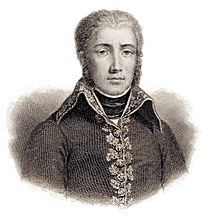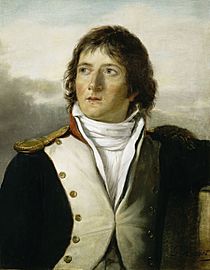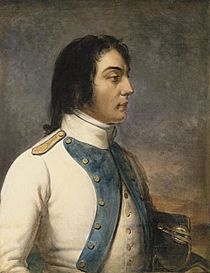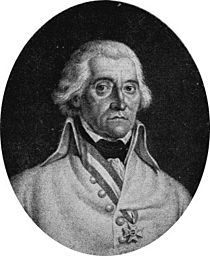Battle of Neresheim facts for kids
Quick facts for kids Battle of Neresheim |
|||||||
|---|---|---|---|---|---|---|---|
| Part of the French Revolutionary War | |||||||
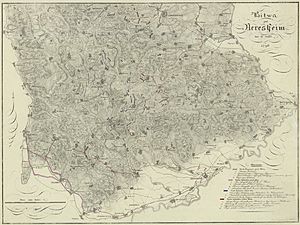 Plan of the battle of Neresheim (published in 1828) |
|||||||
|
|||||||
| Belligerents | |||||||
| Commanders and leaders | |||||||
| Units involved | |||||||
| Strength | |||||||
| 44,737 | 43,000 | ||||||
| Casualties and losses | |||||||
| 2,400–3,000 | 1,600–3,000 | ||||||
The Battle of Neresheim took place on August 11, 1796. It was a fight between the French army, led by General Jean Victor Marie Moreau, and the Austrian army, commanded by Archduke Charles, Duke of Teschen. This battle was part of the larger French Revolutionary Wars, a series of conflicts where France fought against many European countries.
The French army, called the Army of Rhin-et-Moselle, was chasing Archduke Charles's forces. Charles decided to attack the French near Neresheim, a town in Germany. Even though the Austrian army had some success on one side, the battle ended in a tough fight where neither side truly won. Archduke Charles then pulled his troops back even further into Bavaria. The main goal for Charles was to create enough space to move his army safely across the Danube River.
Contents
Background: The French Invasion of Germany
In 1796, two large French armies crossed the Rhine River to invade Germany. General Moreau's army was in the south, and General Jean-Baptiste Jourdan's army was in the north. Their goal was to push into Austrian territory.
The Austrian forces were led by Archduke Charles. He was in charge of two armies: one in the south and one in the north. Charles wanted to gather his forces to fight one French army at a time. He hoped to trick Moreau into moving south of the Danube River. This would keep Moreau's army separate from Jourdan's. To do this, Charles attacked the French, hoping to push them back and give his own troops time to cross the Danube safely.
Moreau's Army and Its Commanders
By June 1796, General Moreau's Army of Rhin-et-Moselle was very strong. It had about 71,581 foot soldiers and 6,515 cavalry (soldiers on horseback), plus artillery. The army was divided into three main parts:
- The Right Wing, led by Pierre Marie Barthélemy Ferino.
- The Center, led by Louis Desaix.
- The Left Wing, led by Laurent Gouvion Saint-Cyr.
Initially, the Austrians had a large army to oppose Moreau. But many Austrian troops were sent to Italy. Maximilian Anton Karl, Count Baillet de Latour became the new commander of the Austrian Army of the Upper Rhine. Archduke Charles took overall command of both Austrian armies.
French Successes and Austrian Retreat
On June 24, 1796, Moreau's army successfully crossed the Rhine River in a battle near Kehl. The French had fewer losses than the German defenders. A few days later, the French won another battle at Renchen. During these movements, Moreau changed his army's setup. Desaix now led the Left Wing, and Saint-Cyr led the Center.
The French continued to push north along the east bank of the Rhine. They forced some Austrian and allied troops to separate from Latour's main army. Ferino's wing chased these separated forces. Meanwhile, Desaix won a small victory against Latour at the Murg River.
Archduke Charles arrived with 20,000 more soldiers. He planned to attack the French, but Moreau attacked first. In the Battle of Ettlingen on July 9, both commanders tried to attack with their right sides. Saint-Cyr's French troops were successful in pushing back the Austrians. Charles worried that Saint-Cyr's advance might cut off his supplies. So, the Archduke ordered a retreat to the east.
Charles continued to retreat, moving his supplies away from the French. Moreau followed him slowly. Some German allies, like the Swabians and Bavarians, started talking with the French about leaving the war. The Saxons, another allied group, marched north to join a different Austrian army. Charles left about 30,000 soldiers in various forts along the Rhine. This meant Charles had fewer troops than Moreau.
As the armies moved, there were small fights almost every day. On August 8, Saint-Cyr's troops took the city of Ulm. Two days later, Charles's left wing rejoined his main army.
The Battle of Neresheim
Archduke Charles wanted to stop Moreau's army from joining with Jourdan's army. Moreau's army was spread out over a wide area. Charles planned to attack on August 11. He sent one group of soldiers to cross the Danube River to get behind the French right side. His troops were ready to move at midnight, but heavy rains slowed them down.
On August 10, Saint-Cyr's troops pushed the Austrians out of a village called Eglingen. Moreau wanted Saint-Cyr to keep pushing, but Saint-Cyr thought the enemy was too strong nearby. Then, heavy rain started, making it impossible for cannons to fire. Moreau did not let Saint-Cyr pull back to a safer spot.
The Attack Begins
Archduke Charles had about 43,000 soldiers, while Moreau had about 44,737. Charles focused his main attack on Saint-Cyr's part of the French army.
At dawn, the Austrians suddenly attacked. A French cavalry unit had to quickly retreat. This left the French foot soldiers at Eglingen without support. Austrian cavalry then attacked the side of a French brigade, causing them to run away. This left Saint-Cyr's division with fewer soldiers to face Charles's attack.
Moreau arrived at Saint-Cyr's headquarters. He agreed to send more troops to support Saint-Cyr and to have his Left Wing attack the Austrian right side. Saint-Cyr placed some of his soldiers at Dunstelkingen and kept others to protect his right side at Dischingen.
At 9:00 AM, the Austrians attacked Dunstelkingen but were pushed back. Their cannons set the village on fire, which actually helped the French by blocking the Austrian advance. Moreau then returned to Saint-Cyr, saying the Left Wing's attack would be delayed.
On another part of the battlefield, Austrian General Hotze took Kösingen. But he faced a new French line on high ground and was pushed back by Desaix's troops. The Austrians also took Bopfingen, but the French were moving to help their center.
A message came that General Duhesme's French division on the far right was in trouble. Austrian forces attacked Duhesme, forcing him to retreat. A large group of Austrian cavalry tried to block the French retreat, but Duhesme managed to escape. Duhesme's division lost some cannons and couldn't rejoin Saint-Cyr for three days.
The Austrians didn't launch any more major attacks on Saint-Cyr's division. By 1:00 PM, the battle mostly became an artillery duel, where both sides fired cannons at each other. Moreau visited Saint-Cyr again, promising that Desaix's attack would happen the next day.
Charles hoped Moreau would give up, but the French army was still in position the next morning. Charles then ordered his troops to retreat. Moreau, worried about running out of cannon ammunition, didn't attack Charles's retreating army. Instead, he held his position, waiting to confirm that the Austrians were crossing the Danube.
Results
The Battle of Neresheim was a tough fight for both sides. Some sources say the Austrians lost about 1,600 to 3,000 soldiers killed, wounded, or captured. The French suffered similar losses, around 2,400 to 3,000 soldiers. The battle is often called a "drawn battle" or a stalemate, meaning neither side won a clear victory.
The Austrian army was able to cross the Danube River safely, destroying the bridges behind them. This was one of Archduke Charles's main goals for fighting the battle. Moreau was very angry with General Duhesme for retreating and removed him from command. However, Saint-Cyr convinced Moreau to change his mind a few days later.
Moreau made a big mistake after the battle. Archduke Charles wanted to join his army with Jourdan's army to defeat Jourdan. When Charles retreated south of the Danube, Moreau could have stayed on the north bank and joined Jourdan. But Charles hoped to trick Moreau into crossing the Danube, which would take him further away from Jourdan. Moreau did exactly that, crossing to the south bank of the Danube a few days later.
Meanwhile, Charles quickly retreated, creating more space between his army and Moreau's. Then, Charles made a smart move: he left some troops to face Moreau and took about 28,000 soldiers back across the Danube to the north bank. He was heading to meet Jourdan's army. Moreau, however, kept moving east on the south bank, unaware of Charles's plan. This allowed Charles to focus on Jourdan's army.
The next important battles were the Battle of Amberg and the Battle of Friedberg, both on August 24, 1796.
See also
- Pope, Stephen. The Cassell Dictionary of the Napoleonic Wars, Cassell (1999)




